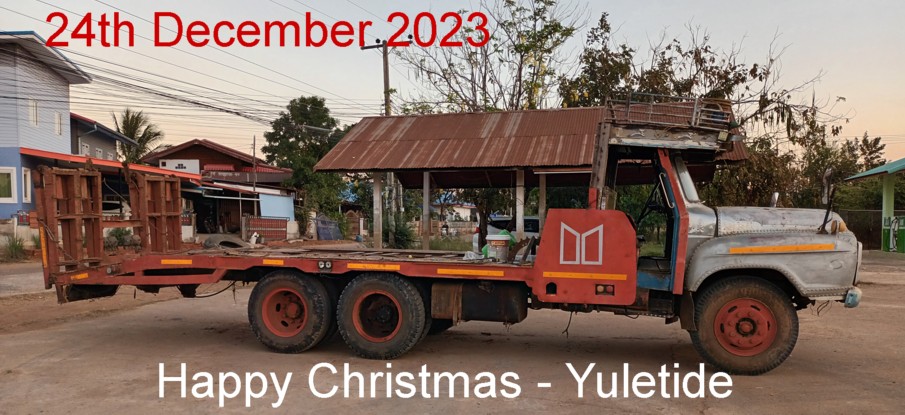
Ban Kwao Yai

Ban Kwao Yai
Ban Kwao Yai is a village
situated not far from Maha Sarakham University out in amongst the
rice fields of rural Isan.
It is where I am stuck this season, far from the fun to be had in
Chiang Mai.
There is an invite from a local farang to join him and his wife
tomorrow afternoon for dinner. His wife preaches at and looks
after a little Christian Church next door to their house and so
Christmas is very much a celebration for her.
Being English, not many of us blokes have the faith nowadays, but
for us the original Pagan celebration of Yuletide is one that
pre-dates Christianity, (it was hijacked when the new religion
became popular), so we can still have a reason to be jolly and
exchanges gifts as well a feast in the original Pagan manner.
Yuletide is a celebration that celebrates evergreen life through
the long European winter. Yuletide begat many of the attributes
we associate with Christmas now, as will Easter, the Springtime
celebration of the resurrection of the European World following
the cold dead of Winter. Eggs and Rabbits, flowing plants,
something much of the Middle East did not enjoy in biblical
times.
Whatever your beliefs, I
wish you all the best this season and in the New Year, to be
followed by the Chinese New Year of the Dragon.
Let's hope the Dragon is nicer to us than the Rabbit has been.
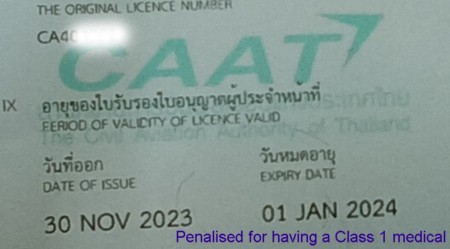

I hate the fact that
sometimes the web re-orientates an image. I'll try something...
The image may be sideways but let's see if this works.
In the past I have had my
validation reduced in time due to having the higher Class One
medical. In the booklet it is stated that this is valid as a PPL
Medical for 24 months; I may only carry fare paying passengers as
a Commercial Pilot for six months from it's initial issue.
In their verification letter Transport Canada did not
specifically state this fact and so CAAT gave me this
ridiculously short validation.
Both CAAT and I are waiting for a response from Transport Canada
to affirm what is already written in my licence booklet.
Chiang Mai Airsports Airshow and Fly-In
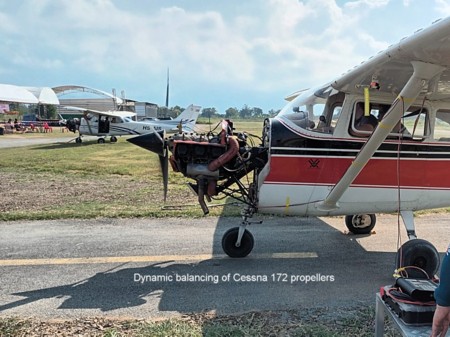
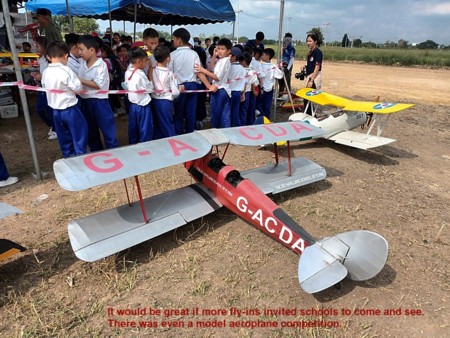
General Aviation is failing
in the North of Thailand as Chiang Mai ATC, botheration, and
personalities clash.
There's not enough cooperation between people who have made
efforts to make flying available to people here, I feel the
conflicts as fiefdoms are created, and then disappear.
An example of this was a friend who loaned his aeroplane to help
a tourism flying business 'get off the ground'. As soon as they
acquired a second aeroplane of their own they evicted him. This
sort of thing is not positive.
As for me, I have a validation to fly aeroplanes of a specific
flying club, but there are no longer any aeroplanes for rent!
However, having obtained one validation, I can obtain another one
for another club for another 2,000 Baht. So the application is in
to be able to fly aeroplanes from Pattaya, but of course the 6
months vs 24 months problem has to be resolved.
I do have a CAA Class 2 medical, valid 24 months as well, but I
have never validated a CAA PPL here. I know there's a written
exchange required to authorise CAA to release my info, and of
course a £45(?) charge and additional time.
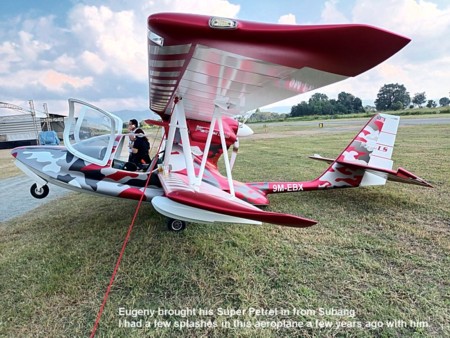
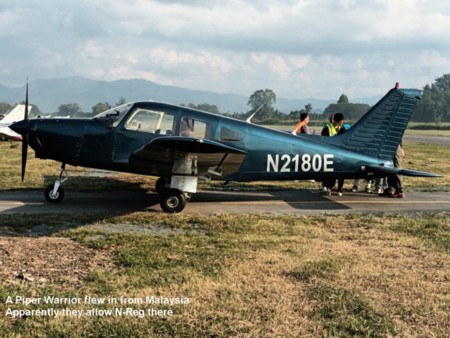
Chiang Mai Air Sports is a
new venture that put in an asphalt runway just over a year ago in
advance of their first Chiang Mai Air Show and Fly-In in December
2022.
This year they repeated the invitation to pilots and the local
people to attend what is to become an Annual Event.
CAAT was there, and together with representatives of local
tourism and business interests there was a meeting in a hotel in
Chiang Mai on the Saturday.
I did not attend this meeting as I saw my responsibility to be
down at the airfield to try to ensure safety and security.
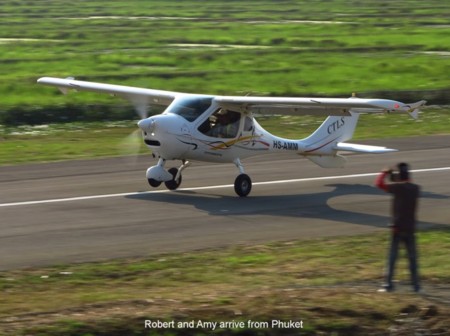
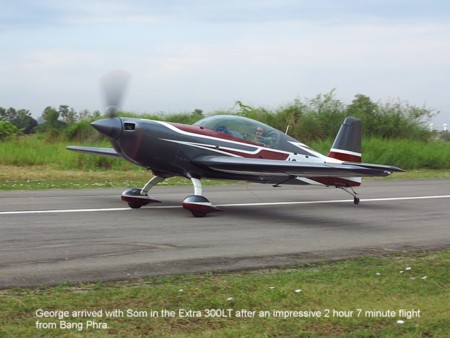
People were allowed to get too close to the
runway and so we moved them back and the crew later added a red
and white plastic barrier tape.

I have little prestige and I know it, so I
attended the event in the little Mazda Familia truck.
An advantage was that the access tracks to the airfield are very
rough and the truck was designed for them.
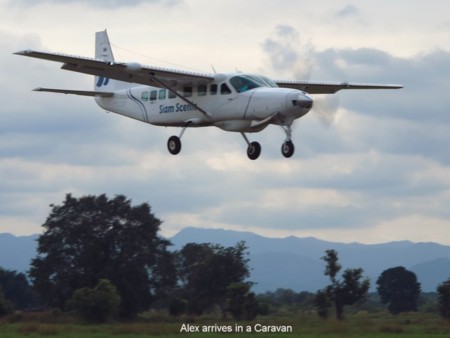
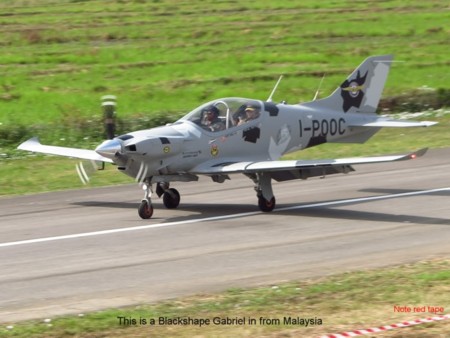
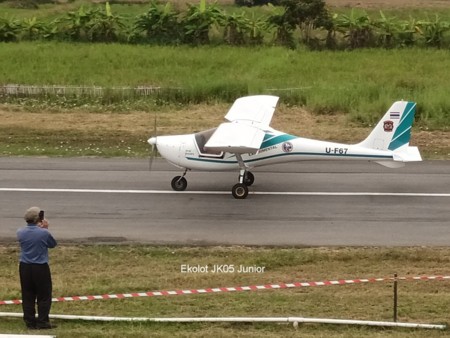
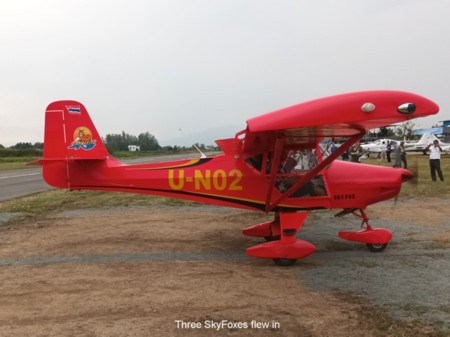
One thing that got me going was when an aeroplane turned left out of taxyway A and fast taxied along the runway to backtrack I thought... No, he was taking off with a full load and only just made it off the ground. The runway is 750 metres long, with 350 metres or less to the threshold of 30! I had a word with the pilot afterwards as such actions cause airfields to be closed here when they go wrong, and an accident investigation takes place.
Then another aeroplane came
in at 80 knots, (I use 70KIAS in this type), and burned rubber as
the brakes were urgently applied. This type is notorious for
porpoising and bending its propeller when landed too fast.
In both cases it's important that the pilot is fully conversant
with the POH or Flight Manual and apply the correct flap setting
for a short field takeoff and the correct approach speed for a
short field landing.
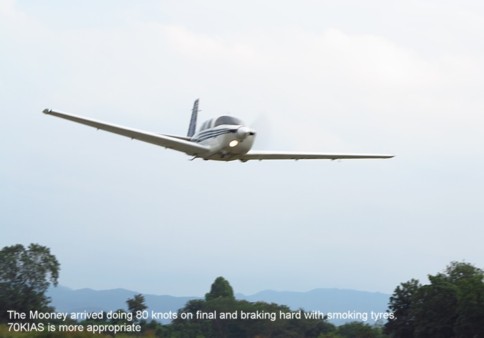
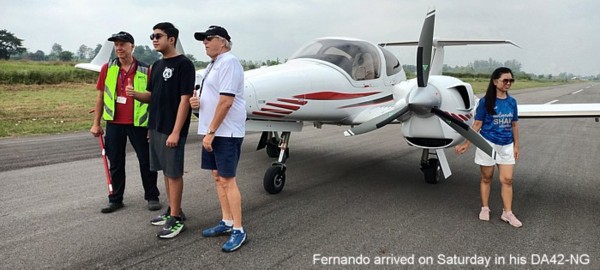
Fernando did a graceful gentle perfect
landing in his DA42.
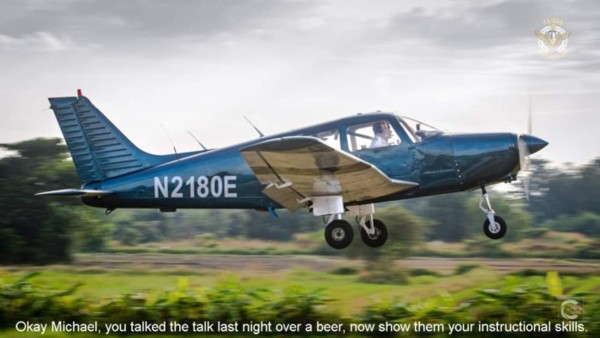
I talk the talk and often I have to walk
the walk, and so one of the Warrior pilots took me over to Mae
On.
We did steep turns, stalls, flight at 70 knots with 25 degrees
flap, and a turn to demonstrate how tight even a
thirty degree bank turn is at this speed, and then returned to do
a couple of soft field landings. It was a good lesson.
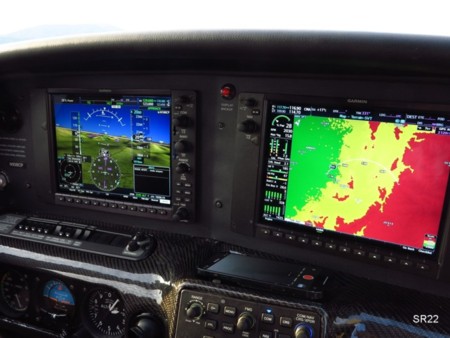
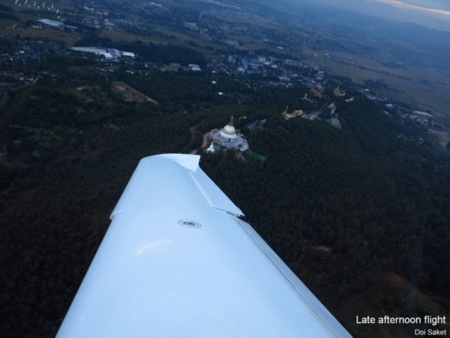
After landing in the Warrior, Jan invited
me along in his Cirrus SR22 as a tour guide since I know the
local area, and I am quite good at liaising with
Chiang Mai Approach, 129.6. We flew to the Hot Springs, then to
Mae Kuang Dam, on to Mae Rim, and then back before the sunset.
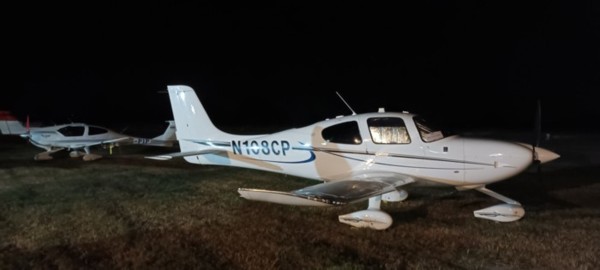
Darkness comes quickly at this latitude.
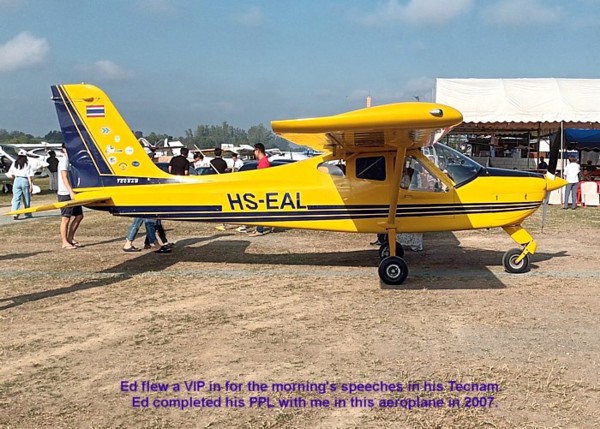
On Sunday morning there
were speeches on a stage, and a parachute drop from 13,000 feet,
after which pilots began their departures.
It was mayhem, as everyone wanted to leave... The DA42 was on an
IFR flight plan which implies having a 'slot'.
Some tempers ran a little high, and too many people called Chiang
Mai Approach on the phone for their clearances. You have to call
Approach for a squawk code and a clearance even though you are on
a VFR flight plan.
Only one person should be doing this, and that would be me I
thought! I had phoned them with a list of aircraft departing in
the order I assumed would work, but then I was surprised to see
others phoning ATC as well...
George suggested a list with time slots that pilots book out
their aircraft in advance. This could be provided to ATC and
departures made in an orderly fashion...
Something to be implimented next year.
It was stressful, and I made a few mistakes, but we coped as well
as we could.
I know I pissed a few people off! Khor thot, I'm sorry.
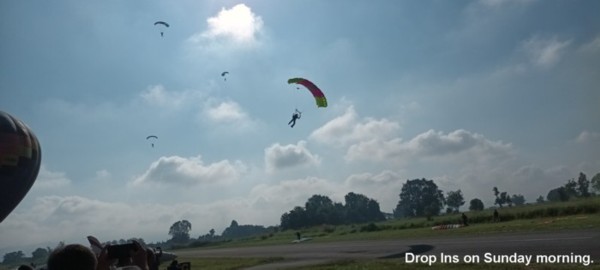
A long drive
On the 11th December I set
off with Khun Ko in her Toyota Vios for Petchabun where we stayed
in a hotel for one night, 400 Baht.
We both developed a bad cold, and it still has not gone as I am
writing this (13 days later).
The next day it was on to Ban Kwao Yai, the village where Khun Ko
was born, and where she still owns a small house.
We stopped frequently... Not well, needing the toilet, and
liquids such as the occasional hot coffee.
After 831.8 kilometres driving from Chiang Mai we arrived, and I
slept off the afternoon on the sofa.
15th December we set off
southbound and stopped for a night near Kabinburi. Everywhere was
booked in the town as there was a festival, and so we drove
another half hour south and stayed in a cabin, 650 Baht a night.
There's an airfield at Kabinburi with a flying school, I missed
out on visiting it this time.
16th December we completed the journey to Ban Nam Mao resort in
Jomtien, and now there was 1,423.9 km on the trip log.
Generally the mainroads are very good here in Thailand. The inner
lanes are often rough due to the heavy lorries that use them, and
so it's best to be in the fast lane as much as is possible while
obediently allowing the speedy drivers to pass by moving over
when necessary.
There are a lot less pot holes than one finds in England.
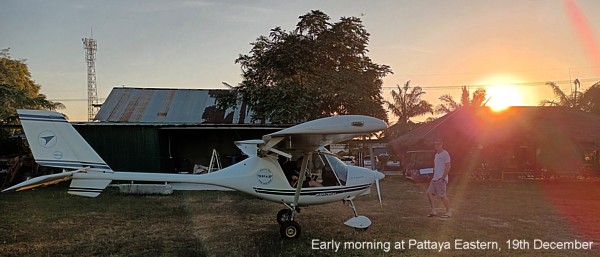
The plan was to get up
early and go flying in the Citabria early Tuesday morning, but
alas the Citabria had a flat tyre, and this would not be fixed
until later.
Early the next morning I was able to go flying with David, up for
some turns, stalls, a spin to the left, then one to the right,
with a barrel and an aileron roll to follow.
We did two stop and go landings.
Then it was the long drive back to Ban Kwao Yai, arriving here at
20:45.
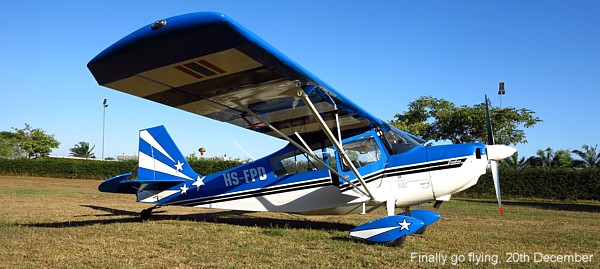
I don't think I will be able to do much flying here in Thailand this time, it seems many things simply do not work out in this year of the Rabbit, everything takes a lot of effort, and consumes much more time than is reasonable.
In England the nose leg for the Aircoupe has finally been successfully re-chromed and is scheduled to be refitted on the 27th, but the aeroplane's annual will run out next month and I will be faced with an expensive bill. At the moment I plan to leave it in the back of the hangar until I can fund its resurrection or I sell it off cheap! Ideally I will retain the pilots who expressed an interest in buying shares, that would help.
Let's hope 2024 will be a better year for all of us.
